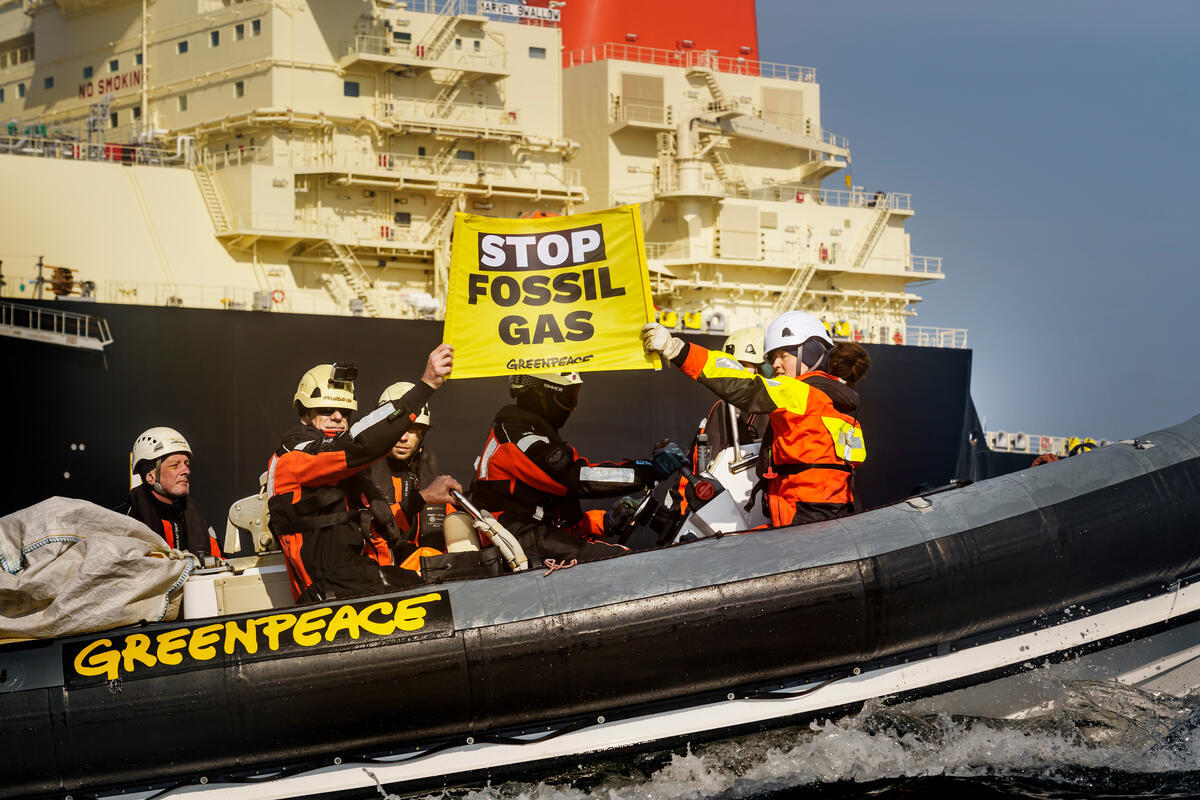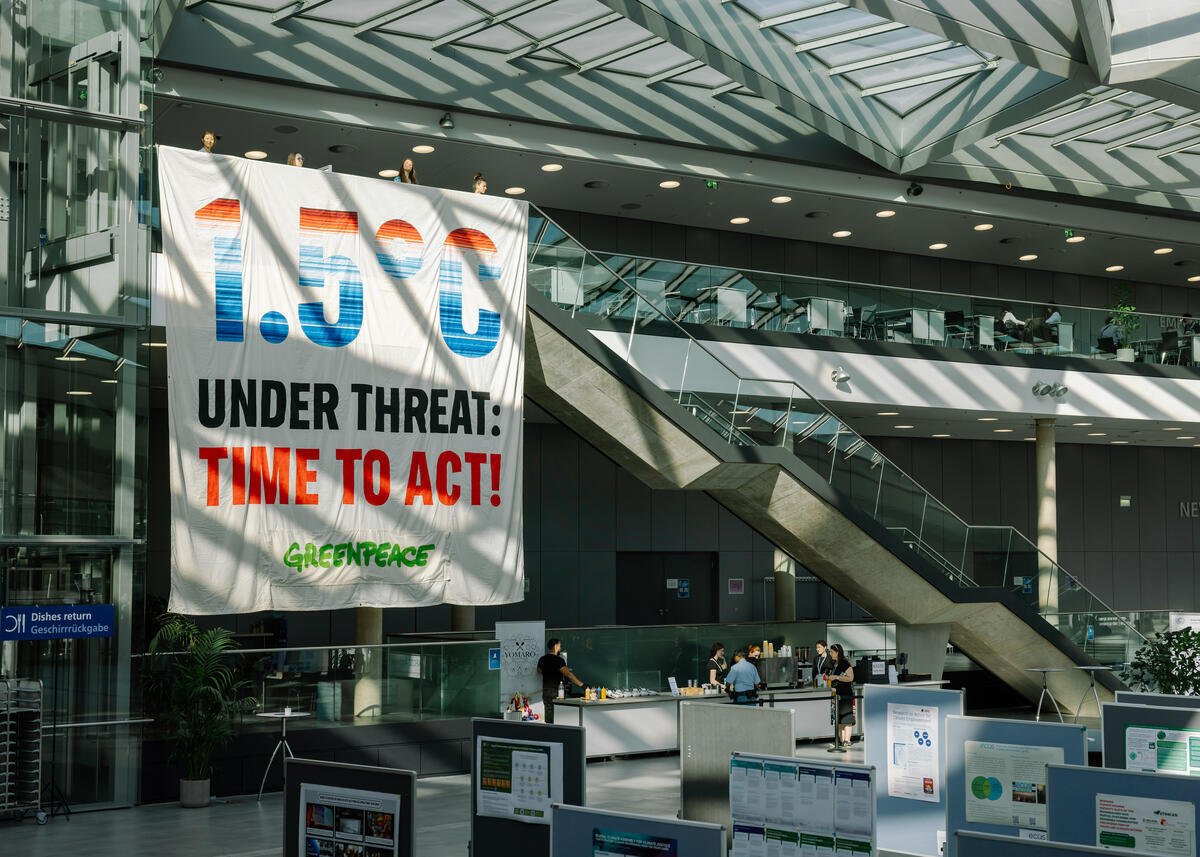Amsterdam – Vladimir Putin’s military invasion of Ukraine poses an unprecedented nuclear threat, with the country’s 15 commercial nuclear reactors, including the largest nuclear plant in Europe, at risk of potentially catastrophic damage that could render vast areas of the European continent, including Russia, uninhabitable for decades, new analysis shows.[1]
At the Zaporizhzhia plant, which produced 19% of Ukraine’s electricity in 2020 and where Russian troops and military hardware are within kilometres,[2] there are six large reactors and six cooling pools with hundreds of tons of highly radioactive nuclear fuel. Three reactors are currently operating and three have been shut down since the start of the war.
The assembled research by specialists for Greenpeace International concludes that the safety of Zaporizhzhia is severely compromised by the war. In a worst-case scenario, where explosions destroy the reactor containment and cooling systems, the potential release of radioactivity from both the reactor core and the spent fuel pool into the atmosphere could create a disaster far worse even than the Fukushima Daiichi catastrophe of 2011, with areas of land hundreds of kilometres from the reactor site potentially becoming inhospitable for decades. Even without direct damage to the plant, the reactor’s rely heavily on the electric grid for operating cooling systems, on the availability of nuclear technicians and personnel and access to heavy equipment and logistics.
Jan Vande Putte, co-author of the risk analysis,[3] said:
“To add to the horrific events of the last week there is a unique nuclear threat. For the first time in history a major war is being waged in a country with multiple nuclear reactors and thousands of tons of highly radioactive spent fuel. The war in southern Ukraine around Zaporizhzhia puts them all at heightened risk of a severe accident. So long as this war continues the military threat to Ukraines nuclear plants will remain. This is one further reason, amongst so many, why Putin needs to immediately cease his war on Ukraine.”
Since the start of the war in Ukraine, Greenpeace International has been closely monitoring the implications for the nuclear installations throughout the country. Today, Greenpeace International has published a technical analysis on some of the major risks at the Zaporizhzhia nuclear power plant in southern Ukraine.
In the case of an accidental bombing and certainly in case of a deliberate attack, the consequences could be catastrophic, well beyond the impact of the Fukushima nuclear disaster in 2011. Because of the vulnerability of the nuclear power plants, its dependency on a complex set of support systems, and the long period of time it takes to bring the power plant into a more passive safety level, the only way to substantially reduce the risks is to halt the war.
Greenpeace wishes to express its deep respect and appreciation to all the workers at the nuclear power plant sites in the Ukraine, including Chornobyl, who are working under extreme conditions to maintain the stability of nuclear power plants.[4] They are not only protecting the safety of their own country but also of a large part of Europe.
The International Atomic Energy Agency (IAEA) Board of Governors held an emergency session Wednesday 2 March to discuss the Ukraine nuclear crisis.[5]
END
Notes:
[1]. “The vulnerability of nuclear plants during military conflict Lessons from Fukushima Daiichi Focus on Zaporizhzhia, Ukraine”, Jan Vande Putte (radiation protection advisor & nuclear campaigner, Greenpeace East Asia & Greenpeace Belgium) and Shaun Burnie (senior nuclear specialist, Greenpeace East Asia) https://www.greenpeace.org/international/nuclear-power-plant-vulnerability-during-military-conflict-ukraine-technical-briefing/ – key findings listed below.
[2] Local reports on 2 March suggested that thousands of civilians in Enerhodar, the host town of the Zaporizhzhia reactors, were attempting to block the advance of Russian troops to the nuclear plant.
Video from the town’s mayor: https://twitter.com/ignis_fatum/status/1498939204948144128?s=21
[3] Jan Vande Putte is a radiation protection advisor and nuclear campaigner for Greenpeace East Asia & Greenpeace Belgium
[4] Chornobyl is the Ukrainian spelling of Chernobyl
[5] The IAEA was notified by the Russian government on 1 March 2022 that Russian military forces had taken control of the territory around the Zaporizhzhia nuclear plant – https://www.iaea.org/newscenter/pressreleases/update-6-iaea-director-general-statement-on-situation-in-ukraine
Contacts:
Shaun Burnie, [email protected]
Jan Vande Putte, [email protected]
Greenpeace International Press Desk: [email protected], +31 (0) 20 718 2470 (available 24 hours)
Follow @greenpeacepress on Twitter for our latest international press releases
Key findings of the Greenpeace analysis are:
- The Zaporizhzhia plant, like all reactors, with hot highly radioactive fuel, requires constant electrical power for cooling even when shut down. When the electricity grid fails and the reactor is in a station black out, there are backup diesel generators and batteries, but their reliability over a longer period of time cannot be guaranteed. There are unresolved on-going issues with the Zaporizhzhia emergency diesel generators, which have an estimated fuel stock on site for only seven days.
- Official data from 2017 reported that at Zaporizhzhia there were 2,204 tons of high level spent fuel – 855 tons of which were in highly vulnerable spent fuel pools. Without active cooling, they risk overheating and evaporating to a point where the fuel metal cladding could ignite and release most of the radioactive inventory.
- Zaporizhzhia, like all operating nuclear power plants, requires a complex support system, including the permanent presence of qualified personnel, power, access to cooling water, spare parts and equipment. Such support systems are severely compromised during a war.
- The nuclear reactor buildings of Zaporizhzhia have a concrete containment protecting both the reactor core, its cooling system and the spent fuel pool. However, such containment cannot withstand the impact of heavy munitions. The plant could be hit accidently. It seems unlikely that the plant would be targeted deliberately, given that the nuclear release could severely contaminate neighbouring countries including Russia. Still, this cannot be entirely ruled out.
- In the worst-case scenario, the reactor containment would be destroyed by explosions and the cooling system would fail, the radioactivity of both the reactor and the fuel pool could then freely escape into the atmosphere. This risks making the entire plant inaccessible because of the high radiation levels, which could then lead to a further cascade of the other reactors and fuel pools, each spreading large quantities of radioactivity into different wind directions over several weeks. It could make a large part of Europe, including Russia, uninhabitable for at least many decades and over a distance of hundreds of kilometres, a nightmare scenario and potentially far worse than the Fukushima Daiichi disaster in 2011.
- It takes a long time to bring a power plant in operation into a stage of passive safety which does not require further human intervention. When a reactor is shut down, the residual heat from the radioactivity decreases exponentially, still it remains very hot and requires cooling over a period of 5 years before it can be loaded into concrete dry storage containers which remove their heat through natural circulation of the air outside the container. Shutting down a reactor might progressively decrease the risks over time, but it does not solve the problem.



